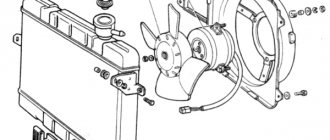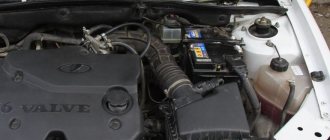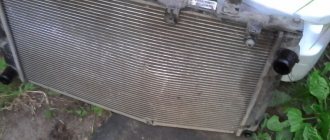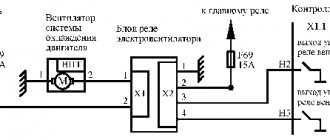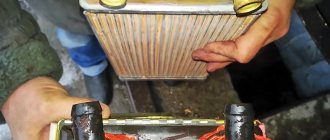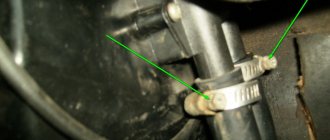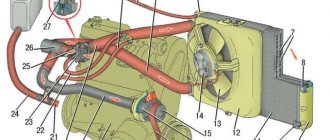Any engine requires cooling during operation. For this purpose, there are special channels in the block, and a thermostat is provided outside. The entire system is connected by pipes. Coolant circulation is ensured by a special water pump. People call it a pump. But that's not all. In order for the engine to warm up quickly, part of the liquid is forcibly “cut off” and does not circulate for a certain time. A thermostat is used to control coolant flows. Signs of its malfunction and the device are further in our article.
How it works?
Any engine uses two circuits:
Both contain coolant. However, after the engine starts, it heats up only in a “small” circle. This way the motor will quickly reach its operating temperature, which, as is known, is 80-90 degrees Celsius. The small circle is the heat exchanger of the stove and the engine itself. The second circuit includes a radiator with pipes, which has a large cooling area. This radiator is located in front of the engine. Additionally, air intake is provided by a special impeller. This could be a viscous coupling or an electric fan. But the operation of these elements no longer depends on the thermostat (the temperature sensor or the crankshaft drive belt is used here).
As you can see, the device has a simple operating principle. However, this mechanism sometimes fails. Signs of a malfunctioning thermostat installed on a Renault Logan are always accompanied by overheating. But first things first. So, below we will look at the main symptoms and signs of a thermostat malfunction.
Logan 1.6 has a copper thermostat. Its service life is quite long (10 years or more). But if it malfunctions, do not hesitate to replace it.
The engine does not warm up to operating temperatures
Oddly enough, these are also common signs of a thermostat malfunction. "Kalina" is also susceptible to this phenomenon. If the valve is stuck in the open position, the fluid constantly circulates in a large circle. The car will take a long time to warm up.
Even while driving, the engine temperature will not exceed 60 degrees. As you can see, overheating is not the main sign of a thermostat malfunction. VAZ classic models are no exception. The motor must operate within its range. Otherwise, the oil viscosity, film properties and valve clearances change. The engine is subject to increased loads.
Instruction No. 1
It often happens that the engine temperature does not rise to the optimal temperature during operation. For example, on the body of a thermostat device, 90 degrees is marked, and the temperature is not higher than 85. This problem can be solved with the help of a simple modification - modifying the rod. The fact is that in the process of opening the thermostat, the rod rests against the cover. If you expand the special recess in the lid, the thermostat will operate later. Therefore, it is easier to replace the rod with a bolt of the appropriate size.
- Pull the rod itself out of the cover.
- Drill a through hole at 4.5.
- Cut the internal thread to 5.
- Select the bolt length with a margin.
- Place a lock nut at 5 and a washer with an elastic band to seal.
- Reinstall the thermocouple.
- Fill with antifreeze.
- Check in practice, adjust the beginning of the opening of the large circle to 89 degrees.
Now the temperature will remain 90-92 degrees, as stated on the thermostat housing.
Why does this happen?
For what reasons does the thermostat break? Signs of malfunction are often caused by a violation of the integrity of the structure. Because wax is placed inside the housing, it leaks out and mixes with the coolant. Violation of tightness occurs due to poor-quality antifreeze or untimely replacement. As a result, the system is subject to corrosion processes. The tubes inside, as well as the thermostat, begin to rust. Due to corrosion, the friction force of the moving rod increases.
How to check the thermostat without removing it from the car? Signs of a bad thermostat
The thermostat is a small part in the mechanism of an internal combustion engine that is responsible for the operation of the cooling system. When this component stops working, thick accumulations of steam begin to emerge from under the hood of the vehicle, a similar picture can often be seen in various films and TV series.
The thermostat mechanically transfers flows of cooled liquid at different temperatures through the cooling system. It works in a large circle when the engine overheats - passing through the radiator, and in a small circle when the engine is cold - bypassing it. If this part does not work correctly, then in the cold season the stove freezes and it is impossible to warm up the car interior. There is a thermostat in both a used car and a new one, if they use a closed version of the liquid cooling system with forced circulation of liquid at a low temperature. The principle of operation of the part is identical for all cars, regardless of the country of manufacture.
Thermostat operating principle
Its main component is a mechanical valve, which begins to work under the influence of a clear mechanism. The hermetically sealed body of the device contains a special heat-sensitive wax, which, under the influence of high temperatures, begins to melt and increase in volume, thereby squeezing the rubber chamber. In turn, the chamber begins to push out a chrome-plated metal rod, which operates the valves.
When the engine starts, the thermostat remains closed so that antifreeze cannot get into the radiator and cool down. During this period of time, it moves along a small circle of the cooling system and cools the heating engine. When the liquid temperature reaches 90 °C, the engine has accelerated to the required mode; if it is above 90 °C, it will begin to overheat, so the antifreeze needs to get rid of the heat and it goes into high gear.
This principle of operation is very simple, but when the integrity of the structure is not respected, the wax can leak out due to the use of low-quality antifreeze (antifreeze) or corrosion processes, which will lead to an increase in the friction force of the moving rod.
Instruction No. 4
If your VAZ-2110 car has a 5-hole thermostat, then it can be modified so that there is one more hole in the body, that is, you need to make a six-hole thermostat from a five-hole thermostat.
Another pipe will be attached to this additional hole to drain spent antifreeze from the heater into the thermostat cavity. Thanks to this modification, the car engine will not become overcooled. There are also instructions for this:
- An additional hole of a standard size of 8 millimeters is drilled in the thermostat housing for another pipe.
- An additional pipe is installed (this must be done parallel to the same “original” pipe, which goes directly to the stove).
- A throttle washer is installed for a hole with a diameter of 8 millimeters (it can be used to increase the flow of antifreeze through the heater when the small circulation circle is open).
Also, we must not forget about the adjusting bolt, which rests on the thermostat housing cover. It serves to regulate the temperature when the thermostat device is opened externally.
If you do not have the time and desire to modify the “original” five-hole thermostat of your car, then you can purchase a new six-hole one, install it and enjoy all the advantages of this device.
How to check the thermostat without removing it from the car
You can only conditionally check the operation of the device without removing it. The only exception is when it is jammed. In such a situation, a conclusion about the serviceability of the thermostat can be made by checking the temperature of the pipes, the period during which the heating took place and the temperature sensor.
To check, turn on the engine and wait 2 minutes, then touch the hose that goes from the thermostat to the radiator. During this time, the valve does not operate yet and the hose should be cold. If it is hot, there is some problem with the valve, and when after some time the hose does not become hot, the valve is jammed and the device should be repaired.
Only specialists can check the thermostat professionally. If there are any complaints about the operation of the engine, it would be better to contact experienced workers and fix the problem in a timely manner.
Latest articles
How to check the thermostat without removing it from the engine
So, the functionality of the thermostat can be checked as follows.
We start the engine and monitor the coolant temperature on the instrument panel. The opening temperature of the VAZ 2110-12 thermostat (main valve) is 85±2°C. When the engine temperature is below the specified value, the operating thermostat valve is closed and the coolant circulates in a small circle. This can be determined by feeling the lower radiator hose and the radiator itself. When the thermostat is closed, they should be cooler than the thermostat itself, since coolant does not enter the radiator.
When the temperature in the cooling system rises to 85 degrees, the main thermostat valve opens and the coolant begins to circulate in a large circle, accordingly the radiator begins to heat up, and then the lower radiator hose.
When the temperature reaches 102°C, the main radiator valve is fully open and the radiator in this case should be hot in the upper part and slightly colder in the lower part, and the lower hose should also be hot.
If, when the temperature is reached when the thermostat valve should open, both the lower pipe and the radiator are cold, then the thermostat valve does not work, and accordingly the thermostat is out of order and needs to be replaced.
A malfunction in which the thermostat does not close completely can be checked just as easily: if after starting the engine the radiator immediately becomes warm like the thermostat housing, but the interior hardly heats up, then the most likely reason for this is incomplete shutting of the thermostat. This can cause the engine to wear out quickly as it does not reach operating temperature. In this case, it will also need to be replaced.
Read more about replacing the thermostat in our separate article.
Where is it located
There are many options for what will happen if the thermostat is constantly open on a large or small circle. This will lead to overheating, antifreeze may be released from the expansion tank, the normal pressure in the cooling system will change, and more.
This unit cannot be allowed to malfunction. It is used on all machines:
- on Kalina;
- on Priora;
- VAZ 2114;
- VAZ Classic;
- Ford Focus;
- VAZ 2110;
- Chevrolet Aveo;
- Gazelle Next;
- VAZ 2107;
- Lada Granta;
- Renault Logan, etc.
To check the serviceability of this element on a car, as well as to detect signs of a dying thermostat, you need to at least roughly understand where it is located.
I can't say it's difficult to do.
It is objectively correct to immediately look at the instruction manual. In the section where the cooling system is described, the location of the required element must be indicated.
At the same time, there is a fairly universal search method that is relevant for almost all domestic cars and many foreign cars.
To find a thermostat you need to do the following:
- open the hood;
- find the thickest pipe;
- this will be the radiator hose;
- it goes from the radiator to the engine;
- the second end of this pipe is connected to the thermostat;
- get to the second end;
- determine the location of the thermostat housing;
- start removing it.
Although I still advise you to first look at the manual, and only then start searching, dismantling and repair work.
Zheka147 › Blog › How to check the thermostat without removing it from the car
The thermostat is a key component of the cooling system, which is responsible for high-quality engine warm-up by timely redirecting coolant flows in a small or large circle.
Failure of this unit inevitably leads to a number of problems - overheating of the motor or the inability of it to reach the desired temperature.
That's why a car enthusiast needs to know how to check the thermostat and what malfunctions of this device exist.
Common causes of breakdowns; Ways to solve problems; We check the device without removal and with dismantling; Features of testing on VAZ cars; We check the device upon purchase; Let's summarize.
Common reasons for device failure
During the operation of the car, the following thermostat breakdowns and the reasons for their occurrence are possible.
1. Increased heating time of the power unit.
The motor operates unstably (for example, it trips), which leads to excessive fluctuations of the thermostat valve and damage to its seat. Due to exposure to strong vibration, damage to the temperature-sensitive element occurs.
The result is that coolant gets inside the unit (wax comes out), which leads to a malfunction of the device, which stops opening or closing the valve when the required temperature level is reached.
2. The valve of the device opens prematurely.
The cause of such a breakdown may be the ingress of coolant into a special element that controls the temperature level of antifreeze in the system.
The result is an increase in the total volume of the filler and premature opening of the valve.
3. The thermostat opens with a delay.
The reason is the appearance of a leak of a special filler that allows the device to respond to temperature changes.
Changing the volume of this element downwards will require more heating to open the valve.
The result is that the thermostat operates with a certain time delay.
4. The engine regularly overheats.
For example, situations are possible when the thermostat allows coolant to pass through on time, but the engine still reaches a high temperature.
The reason is that the fluid is not passing through the main radiator, but is being discharged through the return line back into the engine.
5. The thermostat valve is not fully open due to mechanical damage.
The result is a small volume of liquid entering the radiator to completely reduce the temperature in the system.
6. The valve is not fully closed.
This is possible when coolant “sneaks” into the working element.
Due to the increase in the volume of the working element, the valve disc cannot close completely.
7. Incorrect operation of the device.
For example, opening and closing it ahead of time. This is possible in case of failures in the factory settings and excessive overheating of the cooling system of the power unit.
8. Destruction of the rubber seal.
Due to a breakdown, oil gets into the coolant. The latter acts as a solvent for the rubber valve seal (rubber simply cannot withstand the impact).
Ways to solve problems
Possible solutions to the problem include:
1. If the coolant temperature exceeds the norm (provided the thermostat is working and it is correctly selected), it is necessary to replace the device, but with a higher opening temperature. As a rule, this step is recommended for motorists who operate cars in the mountains and in regions with high average annual temperatures.
2. When opening the thermostat late, it is important to ensure that there are no plugs and that the system is completely filled. If the problem is caused by a plug (coolant stagnation), then the best solution is to make a small hole in the plate (2-3 mm). As a result, the coolant flow near the thermostat is normalized, and the engine warm-up time increases.
3. Early opening of the thermostat is possible due to excessive pressure in the system. Zones of different pressure often appear around the device, which leads to early operation of the valve. There are several reasons:
failure of the cooling system; The thermostat spring has weakened; The engine runs at higher speeds during the warm-up period. 4. The engine takes too long to warm up.
incomplete closing of the thermostat valve; violation of the integrity of the valve plate (for example, a gap has appeared); Incorrect thermostat position (possibly changing the location of the air valve). 5. The engine heats up above normal even in a situation where the thermostat is fully open:
Reasons why a thermostat may fail
The thermostat is responsible for maintaining the optimal temperature of the car engine.
An experienced driver can determine a malfunction of the VAZ-2110 thermostat for indirect reasons. They can be divided into the following points:
- Thermostat takes too long to heat up . This can happen due to unstable operation of the engine, which produces strong vibration. This can damage the valve of the device, causing antifreeze to get inside the thermostat. As a result, the device will work more slowly.
- The valve may also open earlier than expected . As a rule, this is the result of antifreeze getting into the element responsible for coolant temperature.
- The thermostat may open with a delay . Most often, this occurs due to leakage of the filler, which is responsible for the valve opening temperature.
- The thermostat works correctly, but the engine constantly overheats . This may occur due to the coolant moving only in a small circle. The engine may also overheat due to cracks in the pipes or radiator.
- Mechanical damage to the thermostat valve can also prevent it from working correctly.
- Manufacturing defects . Unfortunately, domestically produced spare parts are often produced with factory defects, which can lead to a whole series of unnecessary work, since after changing the thermostat, the car owner will look for the cause of the breakdown anywhere, but not in it.
- Destruction of the rubber seal . If oil gets into the coolant, it can quickly render all rubber parts and pipes that were in contact with the oil unusable.
Oil causes seals to break down.
How to solve problems on the VAZ-2110?
Most thermostat problems can be resolved on your own. As a rule, VAZ-2110 owners do exactly this.
It happens that, despite the normal operation of the thermostat, the temperature of the coolant in the engine is constantly above normal. If you are sure that the thermostat is working properly and the cooling radiator is new, clean and undamaged, then you should replace the device with another one.
Source
VAZ cars: repair, maintenance, tuning
A burst radiator, of course, can be a pity. However, it’s even worse when the engine seizes due to such a seemingly trifle as a non-working thermostat. This is the brain center of the entire cooling and heating system; the thermostat determines how the engine copes with loads and how much fuel it consumes. How to properly check the thermostat on VAZ 2110-2112 engines, how to find a replacement, how to change it correctly and quickly with your own hands - we’ll figure it out right now.
The thermostat is not working. Signs and symptoms
Only the most irresponsible motorist can fail to pay attention to the incorrect operation of the VAZ 2110 engine cooling system. Constant overheating or, conversely, operation at a low coolant temperature threatens not only a high level of wear of rings, pistons and liners. In critical cases, overheating can cause the piston to stick or seize, rotate the main or connecting rod bearings, bend the valves, destroy the camshaft and many other unexpected troubles.
Old and new thermostat valves. Wear is obvious
How does the VAZ 2110 thermostat work?
Theoretically, a tens thermostat is a regular valve that is controlled by a temperature-sensitive element.
Depending on the temperature of the coolant, it either closes the gate and sends antifreeze in a small circle, bypassing the main radiator, or opens it and forces the liquid to circulate in a full circle, including the cooling radiator, heater, engine water jacket, and throttle heating system.
As shown in the diagram, the thermostat is designed as a spring-loaded bypass valve. Under the influence of a spring, it is in the open position and passes liquid in a full circle through the radiator of the cooling system. In this case, the liquid cools faster, but, naturally, warms up very slowly, especially in winter.
Instruction No. 3
Also a popular way to modify the VAZ-2110 thermostat is to reduce the bypass channel. This channel serves to circulate coolant. Experts say: the narrower its diameter, the more antifreeze flows through the heater-stove. And, therefore, the vehicle interior will be warmer. In order to narrow the bypass channel, you must adhere to the following instructions:
- Prepare a thin aluminum plate of a suitable size (several millimeters thick).
- Make a template for the future blank that will be inserted inside the thermostat.
- Cut a plate from an aluminum blank according to the template.
- Secure the new part to the thermostat housing using cold welding or using rivets.
- Drill a hole in the fixed plate - a diameter of 5-6 millimeters (standard hole size is 8 millimeters).
Those who have already made this modification note the following feature: it has become warmer inside the car, but the process of warming up the engine has slowed down somewhat.
Which thermostat is better to install on a VAZ 2110 injector
Until 2003, thermostats of the old design were installed on all VAZ 2110 engines. Its catalog number is 2110-1306010. After 2003, the thermostat was replaced and minor changes were made to the cooling system. In this regard, in dozens of later years of production, thermostats with article numbers 21082-1306010-11 and 21082-1306010-14 . The latter have a higher thermoelement response rate, so preference should be given to them. In addition, there are a huge number of non-original valves and thermostat assemblies on sale. Judging by the reviews of the owners, the valves and thermostats of these companies are considered to be of the highest quality:
- 92C 21082-1306010 , manufactured by LUZAR , the quality is unstable, but if you’re lucky, it will work well;
- assembled housing of the same company with five outlets with catalog number 92C 2190-1306010, LT 01081, without expansion tank fitting or LT 01084 with fitting;
- TN-LA21082 from AURORA;
- Pekar , article 21082-1306030 , good quality and average prices;
- Vernet , article number TH6595.85, one of the most inexpensive on the market;
- STARNER , article number S40 2112 ;
- Finwhale , T111 ;
- BAUTLER, 21082-1306010-11;
- MAHLE / KNECHT , catalog number TH 37 80 ;
- STARLINE , TS T035.92T, one of the best replacements for the original;
- Gates , proven quality, stable temperature, TH21992G1 .
Checking the thermostat in operating mode is carried out only with the valve removed from the vehicle. In principle, if the thermostat is visually coked, shows signs of wear or physical damage, it is better to replace it immediately. And to check it is necessary to remove the thermostat housing from the engine. To do this we do the following:
- With the engine cooled down, drain several liters of antifreeze through the drain hole in the bottom can of the radiator. It is not necessary to drain all the liquid; it is enough to lower its level to the level of the thermostat connector.
- Now we move the container with the drained antifreeze under the thermostat and unscrew it with a 13 key from the cylinder head (on engines manufactured after 2003) or loosen the clamps on older engines.
- We take out the insert with the thermostat valve and place it in a vessel with water.
- The water temperature should be monitored with a thermometer. If the valve opens at a temperature of 90 degrees, it is working. In any other case, the thermostat retires and is replaced with a new insert or assembled with the housing.
- Before installing a new thermostat, we clean the mating surfaces of the thermostat housing and the block head, remove the remnants of the old gasket, degrease the surface and apply a very thin layer of sealant to both surfaces.
- Install the gasket and install the thermostat housing. Depending on the instructions for using the sealant, tighten the bolts immediately or after the specified time. The same applies to adding antifreeze. The instructions for using the sealant may indicate that operation is possible only after a certain time has passed.
- We check the tightness of the bolts/clamps and fill the system with antifreeze.
After replacing the thermostat, we check it in the same way as indicated above, without removing the housing from the engine.

